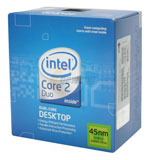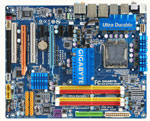Intel Value Midrange
Intel owns the very top in CPU performance with their Core i7, but the Phenom II has made AMD competitive through the upper midrange. That means that midrange is an area where you can now choose Intel or AMD based on the unique features of each platform or expansion capabilities, rather than one brand dominating performance. Since Phenom II is built on a 45nm process, even overclocking capabilities are now competitive with Intel with Phenom II.
The Intel value midrange system builds around a fast Intel Core 2 Duo CPU. For most applications and gaming a faster dual-core CPU is normally a better performance choice that a slower quad-core. CPU intensive applications like video manipulation do benefit from a quad-core CPU, which should be your choice if those applications are important to you. A few recent games are finally taking advantage of quad-core as well, but those are the exception rather than the rule.
| Intel Value Midrange PC | ||
| Hardware | Component | Price |
| Processor | Intel Core 2 Duo E8400 Wolfdale 65W 45nm (3.0GHzx2, 6MB L2) | $165 |
| Cooling | Intel Retail HSF | - |
| Video | PowerColor AX4850 Radeon HD 4850 512MB (after $10 Rebate) | $120 |
| Motherboard | Gigabyte GA-EP45-UD3P (after $20 Rebate) | $115 |
| Memory | 4GB (2x2GB) DDR2-1066 Corsair Twin2X4096-8500C5 5-5-5-15 (after $20 rebate) | $39 |
| Hard Drive | Seagate Barracuda 7200.11 ST31000333AS 1TB | $90 |
| Optical Drive | LG BD/HD DVD / 16x DVD+/- RW GGC-H20LK | $99 |
| Audio | On-Board | - |
| Case | Antec Three Hundred ATX Mid Tower | $55 |
| Power Supply | BFG Tech LS Series LS-550 550W SLI/CrossFire 80 PLUS Certified | $80 |
| Base System Total | $763 | |
| Display | Acer X233Hbid 23" 5ms HDMI Full HD 1080P LCD Monitor (1920x1080) | $190 |
| Speakers | Logitech X-540 70W 5.1 Speakers - Retail | $79 |
| Input | Microsoft CA9-00001 Black PS/2 Standard Keyboard and Optical USB/PS2 Mouse - OEM | $16 |
| Operating System | Microsoft Vista Home Premium OEM | $99 |
| Complete System Bottom Line | $1147 | |
 |
The CPU choice is one of the fastest Core 2 Duo chips with 6MB of L2 cache on the market. The E8400 at 3.00GHz is just two steps below the fastest Core 2 E8600, which clocks at 3.33GHz. It also overclocks exceptionally well, reaching 4GHz and even higher with relative ease. Because of this OC ability, and the value goal of this system build, The E8400 has been matched with components that are also excellent choices for overclocking. The E8400 is plenty fast on its own, but if overclocking interests you this Intel setup will be ready for action - and ready to overclock to wherever your particular E8400 can go.
 |
The big brother to the UD3R selected in our under $800 guide is the $135 Gigabyte GA-EP45-UD3P that has a similar feature set but adds a second x16 slot (in place of a PCI slot) for dual x8 CrossFire operation. You can currently save a few bucks with a $20 mail-in rebate. The board provides an excellent overclocking platform along with great stability. If the second x16 slot is not important to you, we suggest sticking with the UD3R. This P45 chipset motherboard has earned its reputation as a sterling overclocker, while also maintaining excellent stability. It is a good match to the selected Core 2 Duo E8400 or an alternate quad-core Q8200 (2.33GHz 2x3MB L2).
The stock Intel cooler is adequate for modestly overclocking a Core 2 Duo. Better cooling is needed to push the CPU to its capabilities, or if your CPU choice is an Intel quad-core you plan to overclock. The Xigmatek HDT-D1283 120mm Rifle Cooler did very well in our cooling tests and it is a good match to the E8500. OCZ also markets a similar 120 Rifle cooler and either should work well in this system.
For this value midrange system, faster memory with more overclocking head-room was chosen. With the current Corsair rebates some of their best memory is available at truly bargain prices. The choice for the Intel system is a Corsair 4GB DDR2-1066 (PC2-8500) kit. The Corsair Twin X kit specifies fast 5-5-5 timings at DDR2-1066, which is an impressive spec even if you never overclock. Value is good at the normal $59, but with the current $20 rebate the price is a very easy-on-the-budget $39.










73 Comments
View All Comments
jmvillafana - Tuesday, April 14, 2009 - link
The article is excelent. Still if you could run benchmarks with the presented systems we could compare what $1,800 Vs $800 provide.Googer - Monday, April 13, 2009 - link
I must disagree with your selection of Seagate 7200.11 drives after all the problems they have had with failure reminiscent of the IBM Deskstar (deathstar) 75GXP days. Instead, I'd advise users to go with a WD Velociraptor or WD Black edition or a Nice SSD.Leyawiin - Thursday, April 9, 2009 - link
I haven't done a ground up build in years. There's always something you can recycle from a previous build if you do this regularly. I was pricing an i7 940 build with a 300GB Velociraptor, 4GB of DDR3 2000, X58 mobo, Coolermaster V8 HS/fan and a GTX 285. Very strong system and using the still good Cooler Master case, X-Fi sound card, DVD drive and case fans it will be less than $1,700. I might be able to pare it down further.Leyawiin - Thursday, April 9, 2009 - link
Oh and please can the "this is useless unless you live in the US" crap. They can't cover all the international pricing variances - the guides can at least be used as a starting point in your overpriced, uncompetitive locales.papapapapapapapababy - Friday, April 10, 2009 - link
Buyers Guide. Buyers. not -USA- Buyers Guide, or System builders guide. so, yes, is kinda useless 2 me.also, the "Intel Value" config is total crap. stock cooler? XD here, nubcake...
1)
XIGMATEK HDT-S1283 120mm Rifle CPU Cooler $36.99
2)
Intel Core 2 Duo E7400 $119.99 > @ 3.4 GHZ (FASTER + lower temps, noise, price)
also just one hdd? then that mobo is an overkill
3) g31 mobo (ASUS P5KPL-AM) just $37.50 ! thats value (GREAT MOBO, in mot kiding, rock solid, ocs like mad, great sound)
4) GTX 260 896MB for $159.99 + a real psu not that pos
my system >>>>>>>>>>>>>>>>>>>>
>>>>>>>>>><< anand "tech"
papapapapapapapababy - Thursday, April 9, 2009 - link
useless guide unless you live in the usa. ( im sorry 4 you)btw, this is why i always laugh at those American console users, "but the 10.000 computer" " comfy couch" " consoles offer more value" type of guys. they just fail to realize that consoles are super overpriced retro garbage compared to ANY pc . Yes, total garbage, example? console cpu: even a dino like a amd64 3000, or hell even a slow ass barton xp is faster that the " xbox triple core" or the potato of " cell".
edgardavids - Thursday, April 9, 2009 - link
Why do you suggest DDR2-1066 for mid range AMD system? The board can support DDR2-1066 with AM2+ CPU only, X3 720 is a AM3 processor. Is it considered a waste to invest on DDR2-1066?JarredWalton - Thursday, April 9, 2009 - link
See above: AM3 CPUs work with DDR2, and performance wise there's not a huge difference between DDR2 and DDR3 AMD systems. DDR3 is slightly more expensive, but you also need a DDR3 motherboard. Ultimately, the AM2+ boards seem to offer a nice balance of price, performance, and features - whether you use an AM2 or an AM3 CPU.taruncharles - Wednesday, April 8, 2009 - link
Hi,Nice article once gain. I am planning on using the same kinda rig for my mid-range value PC.
In the mid-range value setup, you have used DDR2 1066 with Biostar TA790GX 128M. But, I noticed that the specifications for this motherboard say that it supports DDR2 1066 only for AM2+ CPUs. Whereas the CPU in your setup is AM3..
Will this work properly here. Or should I be using 800Mhz DDR2 with X3 720 and Biostar TA790GX 128M?..
Thanks
Wesley Fink - Wednesday, April 8, 2009 - link
DDR2-1066 and higher speed memory will always work fine at lower speeds and normally faster timings. It is rated 1066 but will definitley work slower if that is necessary, whcih I doubt.